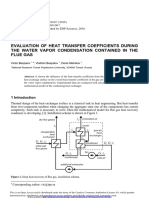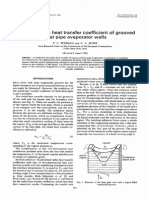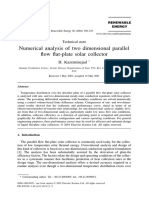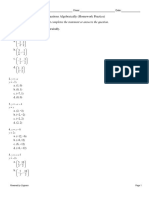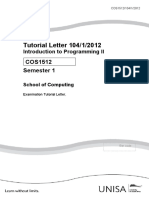Sqy@psu - Edu: Int. Symp. On Heat Transfer in Gas Turbine Systems 9 14 August 2009, Antalya, Turkey
Sqy@psu - Edu: Int. Symp. On Heat Transfer in Gas Turbine Systems 9 14 August 2009, Antalya, Turkey
Uploaded by
Mehdi TaherifarCopyright:
Available Formats
Sqy@psu - Edu: Int. Symp. On Heat Transfer in Gas Turbine Systems 9 14 August 2009, Antalya, Turkey
Sqy@psu - Edu: Int. Symp. On Heat Transfer in Gas Turbine Systems 9 14 August 2009, Antalya, Turkey
Uploaded by
Mehdi TaherifarOriginal Title
Copyright
Available Formats
Share this document
Did you find this document useful?
Is this content inappropriate?
Copyright:
Available Formats
Sqy@psu - Edu: Int. Symp. On Heat Transfer in Gas Turbine Systems 9 14 August 2009, Antalya, Turkey
Sqy@psu - Edu: Int. Symp. On Heat Transfer in Gas Turbine Systems 9 14 August 2009, Antalya, Turkey
Uploaded by
Mehdi TaherifarCopyright:
Available Formats
Int. Symp.
on Heat Transfer in Gas Turbine Systems 9*14 August 2009, Antalya, Turkey
CALCULATION OF GAS TURBINE BLADE TEMPERATURES USING AN ITERATIVE CONJUGATE HEAT TRANSFER APPROACH Mangesh Kane and Savas Yavuzkurt1 Department of Mechanical and Nuclear Engineering The Pennsylvania State University, University Park, PA 16802, USA (1 Corresponding author: sqy@psu.edu)
INTRODUCTION One of the most important goals of the gas turbine industry is to produce a gas turbine with an increased thermal efficiency, higher power to weight ratios and reliability. The gas turbine industry is continuously putting an effort on increasing the turbine inlet temperatures to increase the turbine efficiency. But increasing inlet temperature has adverse effects on the life and reliability of the components of the gas turbine. Thus it is important to accurately predict the heat load applied to the components and their temperatures near the combustor for these high inlet temperatures. Analytical Studies: Numerous studies have been done in the past on gas turbine heat transfer. The simultaneous calculation of conduction and convection is called conjugate heat transfer. Luikov [1974] presented a solution for laminar, incompressible flow over a flat plate. His results made a good agreement with the exact solution for local Brun number in the range 0 < Brx < 1.5. Researchers [1974-1999] presented solutions for flow over flat plate, vertical plate, cone, and wedge. They also showed the conjugate results fit analytical results and are better than the ones obtained using nonconjugate method. They achieved accuracies of 1-2% for Nusselt number for low thermal conductivity and 5% for high values of thermal conductivity. Numerical and Experimental Studies: Rigby and Lepicovsky [2001] presented two simple cases to validate the conjugate heat transfer code for turbomachinery applications. Discrepancies in results of Nusselt number comparison was due to the assumption of one dimensional heat conduction. Bohn et al. [1997] presented a 3D simulation of the film cooled turbine blade and showed that for 3D simulation for exact determination of boundary conditions from the experiments is necessary. Their conjugate studies to a film cooled turbine blade predicted 8% of difference in temperatures for conjugate and decoupled conventional approach. York et al., [2003] presented a complete 3D conjugate heat transfer simulation on C3X turbine blade and compared the results with the data of Hylton et al., [1983]. They simulated the two cases for different Mach numbers and their results showed a very good agreement(within ~7-8%) with the experimental results. The conjugate approach involves time consuming calculation as the number of grid points increase as both fluid and solid domain have to be taken in to consideration. An enormous care need to be taken while meshing the interface as the temperature gradient is high in this region and also time averaged turbulence quantities such as turbulent kinetic energy and its dissipation need to be resolved accurately. However conjugate approach makes it possible to specify more accurate boundary conditions. In certain situations the calculations of the gas side heat transfer coefficients are in error due to complex geometries such as film cooling and inability of turbulence models to predict the flow correctly especially in the near field of the film cooling holes. In fact even in simple geometries simulations can give 5-10% deviation from data for heat transfer coefficients. To
Int. Symp. on Heat Transfer in Gas Turbine Systems 9*14 August 2009, Antalya, Turkey
get around this problem in calculating gas turbine blade temperatures some designers prefer to use their experimental data taken on gas side heat transfer coefficients and solve the heat transfer problem within the solid itself only. However, gas side boundary condition usually specified in terms of heat flux on surface or surface temperature. Although h is known, calculation of heat flux requires an assumed surface temperature. This assumption requires iteration of temperatures of the surface until given heat flux, h and temperatures all fit together. In FLUENT code these iterations are carried out internally by supplying h and using a convective boundary condition. In this paper this new approach is introduced where only conduction in the blade material will be solved using experimental heat transfer coefficient h on the gas side as boundary condition. OBJECTIVES The objective of this manuscript is to present the results of iterative conjugate heat transfer(CHT) calculations of gas turbine blade temperatures obtained using FLUENT [2006] code. One of the goals is to discuss the similarities and differences between the results of iterative CHT, full CHT and nonCHT calculations as well as compare them with experimental data. One very important objective is to supply information to gas turbine industry and researchers about the new iterative technique for calculating blade temperatures. ITERATIVE TECHNIQUE Simulations of an incompressible, 2D, turbulent flow over Mark-II blade [Hylton, 1983] was carried out using FLUENT code. The simulation geometry and grid are prepared using the preprocessor GAMBIT [2007]. An unstructured grid is used for the overall domain(both for gas and solid) and boundary layer grid was used to resolve the near wall region(both for gas and solid).For turbine blade calculations 111815 grid points were used. Boundary conditions applied were given in the experimental study carried by Hylton et al., [1983]. The two-equation Realizable k- model was used in simulations since it was shown that the model gave better results for heat transfer coefficients and temperatures compared to Standard and RNG model for flat plate boundary layer baseline studies. The problem is solved by two approaches, one is constant wall temperature and the other is conjugate. In the iterative approach, only solid blade is simulated and the boundary condition for the blade surface is found using experimental data on h. Data for heat transfer coefficient for blade suction and pressure surface is plotted in MATLAB. A 10th order polynomial is used to fit the data and an equation was obtained for the heat transfer coefficient as a function of distance along the blade surface. The boundary condition of heat flux obtained from assumed wall temperatures and heat transfer coefficient on the pressure and suction surfaces was supplied to FLUENT using the User Defined Functions (UDF) feature. RESULTS AND DISCUSSION Figure 1 shows the heat transfer coefficient normalized by href(given on the figure) along the blade surface with both non-conjugate and full conjugate simulations. Non-conjugate calculations are carried out using a constant wall temperature. Overall conjugate results are 13% higher compared to the data. But near the leading edge error is about the 40% and that can be because of acceleration after stagnation point and FULENT code cannot predict the relaminarization at this point. Overall it can be seen that conjugate results agree with data much more than non-conjugate results. The non-conjugate simulation results are under predict the data in the range of 20% and for the downstream of suction edge deviations from data are around 25%. From the results it can be seen that the more realistic results are obtained by full conjugate analysis.
Int. Symp. on Heat Transfer in Gas Turbine Systems 9*14 August 2009, Antalya, Turkey
1.2 1 0.8
Hylton et al (1983) Conjugate- k- Realizable Non-conjugate- k- Realizable
href = 1135 W/m2 K
h/ href
0.6 0.4 0.2 0 -1 Pressure Side -0.5 0 Suction Side 0.5 1
x/L Fig 1.Heat transfer coefficient along the blade surface Figures 2 and 3 show the dimensionless temperature distribution along pressure and suction surfaces of the blade respectively obtained using full conjugate and iterative conjugate simulation. Results were compared with the experimental data. In the full conjugate simulation, average error on the pressure side is much less than the error on the suction surface which is around 14%. Discrepancies up to 10% are generally accepted when simulations are done using k- turbulence model. The deviations from data near the leading edge are large as 20%.
1.0 0.9 0.8
T / Tref
Hylton et al., 1983 k- Realizable Iterative Method
1.0 0.9 0.8
T / Tref
Hylton et al., 1983 k- Realizable Iterative Method
0.7 0.6 0.5 0.4 0.00
Tref = 811K
0.7 0.6 0.5 0.4 0.00 0.05
Tref = 811K
0.15 s/c 0.10 Fig 2. Temperature along the pressure surface
0.05
s/c Fig 3. Temperature along the suction surface
0.10
0.15
In iterative conjugate analysis the experimental heat transfer coefficient obtained from Hylton [1983] is used as a boundary condition and hence the results were much more accurate than the conjugate results. The surface temperatures were over predicted near the leading edge by about 7% and under predicted over the surface by 4%. Near the trailing edge again the results were over predicted by 5%. The average deviation from data with the iterative method is around 5%. The research on prediction of heat transfer characteristics of film-cooled blades using this technique is continuing.
Int. Symp. on Heat Transfer in Gas Turbine Systems 9*14 August 2009, Antalya, Turkey
CONCLUSION Data from Mark II blade was used to study the conjugate heat transfer for a gas turbine blade using FLUENT code. Realizable k- model with enhanced wall treatment was used in simulations. Requirement of care in setting up exact boundary conditions from experimental data are the basis of using conjugate simulations. The results from conjugate approach were compared with conventional non-conjugate approach. It was seen that the conjugate calculations resulted much better predictions of heat transfer coefficients when compared to experimental data. Near the leading edge both approaches deviated about 30% of the data. The relaminarization at the leading edge due to high flow acceleration is thought to be the cause of this which cannot be simulated in FLUENT code at this point. In the new iterative conjugate approach only conduction heat transfer within the blade material is calculated using experimental heat transfer coefficient as a boundary condition which cuts down the computational time in a great extent. The local heat transfer coefficient was supplied to FLUENT code through UDF. The change in local surface temperature before every iteration was observed and iterative technique was validated. It can be seen that the iterative technique gives much better blade temperatures than the full conjugate analysis since the calculation of flow field in full conjugate has error whereas experimental h is much more reliable. REFERENCES Bohn, D. E., Becker, V. J., and Kusterer, K. A., [1997], 3-D Conjugate Flow and Heat Transfer Calculations of a Film-Cooled Turbine Guide Vane at Different Operation Conditions, ASME Paper No. 97-GT-23. FLUENT [2006], ANSYS Inc. FLUENT 6.3 Documentation. GAMBIT [2007], ANSYS Inc. GAMBIT 2.4 Documentation. Hylton, L. D., Millec, M. S., Turner, E. R., Nealy, D. A. & York, R. E., [1983], Analytical and Experimental Evaluation of the Heat Transfer Distribution Over Surface of Turbine Vanes, NASA-Report CR 168015. Luikov, A. V. [1974], Conjugate convective heat transfer problems, Int. J. Heat Mass Transfer, 17, 257-265. Mosaad, M., [1999], Laminar forced convection conjugate heat transfer over a flat plate, Heat and Mass Transfer 35, 371-375. Rigby, D. L. and Lepicovsky, J., [2001], Conjugate Heat Transfer Analysis of Internally Cooled Configurations, ASME Paper No. 2001-GT-0405. York, W. D. and Leylek, J. H., [2003], Three-Dimensional Conjugate Heat Transfer Simulation of an Internally-Cooled Gas Turbine Vane, Proceedings of ASME Turbo EXPO 2003, GT200338551. Yu, W., Lin, H., and Hwang T. [1991], Conjugate heat transfer of conduction and forced convection along wedges and a rotating cone, Int. J. Heat Mass Transfer, vol. 34, no. 10, pp.2497-2507. Yu, W., and Lin, H., [1993], Conjugate problems of conduction and free convection on vertical and horizontal plates, Int. J. Heat Mass Transfer, vol. 36, no. 5, pp.1303-1313.
You might also like
- Guidelines For Ethylene Quench Tower Rev IntroDocument12 pagesGuidelines For Ethylene Quench Tower Rev IntroGuntoro AliNo ratings yet
- Axial Effects of Borehole DesignDocument8 pagesAxial Effects of Borehole Designsema tekinNo ratings yet
- A Temperature Wall Function Formulation ForDocument13 pagesA Temperature Wall Function Formulation Forbmw530liNo ratings yet
- Homework 2.2Document11 pagesHomework 2.2GalimoNo ratings yet
- Modified Values For Geometric Factor of 00193924Document7 pagesModified Values For Geometric Factor of 00193924Gilberto MejíaNo ratings yet
- International Journal of Heat and Mass Transfer: Cheen Su An, Man-Hoe KimDocument6 pagesInternational Journal of Heat and Mass Transfer: Cheen Su An, Man-Hoe KimnaveenNo ratings yet
- Faizan Ahmad, Amjad Riaz : Application of Computational Fluid Dynamics - Optimal Cooling of Hardware ComponentDocument10 pagesFaizan Ahmad, Amjad Riaz : Application of Computational Fluid Dynamics - Optimal Cooling of Hardware ComponentAmjadRiazNo ratings yet
- 1.pdf 2 PDFDocument20 pages1.pdf 2 PDFMurtadha AhmedNo ratings yet
- A Theoretical Analysis and CFD Simulation On The Ceramic Monolith Heat ExchangerDocument12 pagesA Theoretical Analysis and CFD Simulation On The Ceramic Monolith Heat ExchangerMohamed AshrafNo ratings yet
- Welding FormulaDocument6 pagesWelding FormulachirpynikNo ratings yet
- Jten 2023 9 3.21200Document16 pagesJten 2023 9 3.21200sedatkanburrNo ratings yet
- Thermal Modeling of Isothermal Cuboids and Rectangular Heat Sinks Cooled by Natural ConvectionDocument8 pagesThermal Modeling of Isothermal Cuboids and Rectangular Heat Sinks Cooled by Natural ConvectionRam MurtyNo ratings yet
- Prediction of Thermal Fatigue Life of A Turbine Nozzle Guide VaneDocument9 pagesPrediction of Thermal Fatigue Life of A Turbine Nozzle Guide VanejswxieNo ratings yet
- Modelling Phase Change in A 3D Thermal Transient AnalysisDocument22 pagesModelling Phase Change in A 3D Thermal Transient AnalysisDimuthu Prasad WijethungeNo ratings yet
- Design and Development of A Low-Cost Thermal Response RigDocument4 pagesDesign and Development of A Low-Cost Thermal Response RigChristos StiapisNo ratings yet
- Guidelines For Ethylene Quench Tower Rev 17Document17 pagesGuidelines For Ethylene Quench Tower Rev 17totongop0% (1)
- Three Dimensional Finite Element Modelling of Truck Tyre Curing Process in MouldDocument9 pagesThree Dimensional Finite Element Modelling of Truck Tyre Curing Process in Mouldbhushan5004No ratings yet
- Model For Simulation of Conventional Drying of Paper: A. Hazi and Gh. HaziDocument6 pagesModel For Simulation of Conventional Drying of Paper: A. Hazi and Gh. HaziAneta HaziNo ratings yet
- Conjugate Heat Transfer PDFDocument10 pagesConjugate Heat Transfer PDFbenabedmNo ratings yet
- Evaluation of Heat Transfer Coefficients During The Water Vapor Condensation Contained in The Flue GasDocument5 pagesEvaluation of Heat Transfer Coefficients During The Water Vapor Condensation Contained in The Flue GasreaktorenergiNo ratings yet
- Batch and Semibatch Reactor Performance For An ExothermicDocument8 pagesBatch and Semibatch Reactor Performance For An ExothermicGiorolongNo ratings yet
- Applied Energy: Varun, SiddharthaDocument7 pagesApplied Energy: Varun, SiddharthaResearcherzNo ratings yet
- Analysis of Heat Transfer, Friction Factor and Exergy Loss in Plate Heat Exchanger Using FluentDocument8 pagesAnalysis of Heat Transfer, Friction Factor and Exergy Loss in Plate Heat Exchanger Using FluentFadi YasinNo ratings yet
- Thermal Analysis of A Commercial Plate Fin Heat Exchanger With Non-Uniform Inlet Flow ConditionsDocument47 pagesThermal Analysis of A Commercial Plate Fin Heat Exchanger With Non-Uniform Inlet Flow ConditionsdondiNo ratings yet
- Finned Tube R134a CondenserDocument12 pagesFinned Tube R134a CondensermattiturboNo ratings yet
- Araba Radyatörü HesabıDocument11 pagesAraba Radyatörü HesabıacankaragozNo ratings yet
- Pinch ExampleDocument6 pagesPinch Exampledlalameen4471No ratings yet
- Electro-Thermal Simulation of Lithium Ion Battery For EV/HEV ApplicationsDocument11 pagesElectro-Thermal Simulation of Lithium Ion Battery For EV/HEV ApplicationsSagar PatilNo ratings yet
- Thermal ResistivityDocument16 pagesThermal ResistivityRaj PanwarNo ratings yet
- Research Inventy: International Journal of Engineering and ScienceDocument5 pagesResearch Inventy: International Journal of Engineering and ScienceinventyNo ratings yet
- Numerical and Experimental Study On Temperature Crossover in Shell and Tube Heat ExchangersDocument17 pagesNumerical and Experimental Study On Temperature Crossover in Shell and Tube Heat ExchangersRisto FilkoskiNo ratings yet
- On The Analysis of Temperature Dissipation in A Turbulent Jet Propane Flame - ETFS18 - 1998Document6 pagesOn The Analysis of Temperature Dissipation in A Turbulent Jet Propane Flame - ETFS18 - 1998Armando Caldeira PiresNo ratings yet
- Thermal ResistanceDocument8 pagesThermal ResistanceLakshmi BalasubramaniamNo ratings yet
- Conjugate Calculation of A Film-Cooled Blade For Improvement of The Leading Edge Cooling ConfigurationDocument9 pagesConjugate Calculation of A Film-Cooled Blade For Improvement of The Leading Edge Cooling ConfigurationVibhanshu VermaNo ratings yet
- 217 560 2 PBDocument15 pages217 560 2 PBRukhsar ParveenNo ratings yet
- Lifetime Prediction of Thermo-Mechanical Fatigue For Exhaust ManifoldDocument10 pagesLifetime Prediction of Thermo-Mechanical Fatigue For Exhaust Manifoldram shyamNo ratings yet
- Numerical Analysis of Factors Affecting The Range of Heat Transfer in Earth Surrounding Three SubwaysDocument5 pagesNumerical Analysis of Factors Affecting The Range of Heat Transfer in Earth Surrounding Three SubwaysmusNo ratings yet
- Azojete 15 (2) 314-328 PDFDocument15 pagesAzojete 15 (2) 314-328 PDFAZOJETE UNIMAIDNo ratings yet
- Temperature Prediction On A Turbine Blade Using A Combination of Turbulent and Laminar Flow ModelsDocument5 pagesTemperature Prediction On A Turbine Blade Using A Combination of Turbulent and Laminar Flow ModelskasemeidNo ratings yet
- 1-Le CorreDocument7 pages1-Le CorreJose Luis RattiaNo ratings yet
- Lec 11 1Document21 pagesLec 11 1rozNo ratings yet
- Coupled AnalysisDocument7 pagesCoupled AnalysisrshegdeNo ratings yet
- Analisis de Transferencia de Calor en Un EvaporadorDocument9 pagesAnalisis de Transferencia de Calor en Un EvaporadorMaria Alejandra RamirezNo ratings yet
- Turbine Blade Cooling by Air Using Different MethodsDocument22 pagesTurbine Blade Cooling by Air Using Different MethodsclaudiomctNo ratings yet
- 1000455.energies 12 01787Document18 pages1000455.energies 12 01787Halil yıldırımNo ratings yet
- Exhaust ManifoldDocument5 pagesExhaust ManifoldDeepak Chachra100% (1)
- Liu2004 PDFDocument9 pagesLiu2004 PDFLỢI NGUYỄN CÔNGNo ratings yet
- 7.an Improved Lumped Analysis For Transient Heat ConductionDocument6 pages7.an Improved Lumped Analysis For Transient Heat ConductionAnkit Daiya (B20ME013)No ratings yet
- CMEM01060FUDocument12 pagesCMEM01060FUAbeje AlemnewNo ratings yet
- 3-D Numerical Simulation of Swirling Flow and ConvectiveDocument24 pages3-D Numerical Simulation of Swirling Flow and ConvectiveVenkat Rajesh AnapuNo ratings yet
- MickeyDocument9 pagesMickeyyuritaariasNo ratings yet
- Intelligent Control Based Estimation of Heat Transfer Coefficient From Four Flat Tubes With Different Attack Air AnglesDocument14 pagesIntelligent Control Based Estimation of Heat Transfer Coefficient From Four Flat Tubes With Different Attack Air AnglesAhmed HasanNo ratings yet
- Investigation of The Ambient Temperature Effects On Transformers Insulation LifeDocument5 pagesInvestigation of The Ambient Temperature Effects On Transformers Insulation Lifevzimak2355No ratings yet
- Numerical Analysis of Two Dimensional Parallel Flow Flat-Plate Solar Collector by KazeminejadDocument15 pagesNumerical Analysis of Two Dimensional Parallel Flow Flat-Plate Solar Collector by KazeminejadAncelmo Queiroz JúniorNo ratings yet
- Thermal Analysis of In-Situ Thermoplastic Composite Tape LayingDocument26 pagesThermal Analysis of In-Situ Thermoplastic Composite Tape Layingduchm-tfaNo ratings yet
- Guidelines For Ethylene Quench Tower Rev IntroDocument13 pagesGuidelines For Ethylene Quench Tower Rev IntroMubarik AliNo ratings yet
- Ijest10 02 07 75Document7 pagesIjest10 02 07 75C Krishna KanthNo ratings yet
- Determination of Surface Convective Transfer Coefficients by CFD - Adamneale PDFDocument12 pagesDetermination of Surface Convective Transfer Coefficients by CFD - Adamneale PDFMustafa YılmazNo ratings yet
- International Communications in Heat and Mass Transfer: Sheng-Chung Tzeng, Tzer-Ming Jeng, Yi-Liang LinDocument9 pagesInternational Communications in Heat and Mass Transfer: Sheng-Chung Tzeng, Tzer-Ming Jeng, Yi-Liang Linvijay2293No ratings yet
- 5 Session 18-19 (Z-Test and T-Test)Document28 pages5 Session 18-19 (Z-Test and T-Test)Shaira CogollodoNo ratings yet
- Fuzzy Set Approaches To Classification of Rock Masses: A. AydinDocument19 pagesFuzzy Set Approaches To Classification of Rock Masses: A. AydinkhilNo ratings yet
- Inorganic & Organic Chemistry (Trans) Introduction To Chemistry (Oct. 1,2021)Document5 pagesInorganic & Organic Chemistry (Trans) Introduction To Chemistry (Oct. 1,2021)Jamaica SalvadorNo ratings yet
- Melli Eliza (Kel - 10)Document18 pagesMelli Eliza (Kel - 10)RizkyNo ratings yet
- Lesson 3-8 Solve Systems of Equations Algebraically (Homework Practice)Document4 pagesLesson 3-8 Solve Systems of Equations Algebraically (Homework Practice)nonNo ratings yet
- Stability of Slender Columns PDFDocument70 pagesStability of Slender Columns PDFmagdy bakryNo ratings yet
- Primary-3 SIN 2017Document12 pagesPrimary-3 SIN 2017Thuy NguyenNo ratings yet
- Nonlinear Curve Fitting: "Why Fit in When You Were Born To Stand Out?" - Dr. SeussDocument65 pagesNonlinear Curve Fitting: "Why Fit in When You Were Born To Stand Out?" - Dr. Seussomarkhaled200321No ratings yet
- Middle-Primary-Grade 3,4 Fractions and Decimals: Choose Correct Answer(s) From The Given ChoicesDocument9 pagesMiddle-Primary-Grade 3,4 Fractions and Decimals: Choose Correct Answer(s) From The Given ChoicesMahfuz RahmanNo ratings yet
- Computation Of: Single Trade Discount Discount SeriesDocument9 pagesComputation Of: Single Trade Discount Discount SeriesloraineNo ratings yet
- (IJCST-V9I2P10) :DR - Shine N DasDocument6 pages(IJCST-V9I2P10) :DR - Shine N DasEighthSenseGroupNo ratings yet
- Pradip Patel Kunal ShahDocument15 pagesPradip Patel Kunal ShahPradeep PatelNo ratings yet
- Du-Gia-Phu Answer Chapter 5 MAD101-1Document5 pagesDu-Gia-Phu Answer Chapter 5 MAD101-1Võ Thái Hoàng AnhNo ratings yet
- Plane GeometryDocument2 pagesPlane GeometryJirah Gicangao100% (1)
- Tutorial - I (Ee 311)Document2 pagesTutorial - I (Ee 311)Ashok KumarNo ratings yet
- OBE Presentation NEWDocument38 pagesOBE Presentation NEWNafees Ur RehmanNo ratings yet
- Air-Jet Texturing PDFDocument0 pagesAir-Jet Texturing PDFNessre ZeineNo ratings yet
- 5 Calculus Final Test 2018-2019 Semester 1Document2 pages5 Calculus Final Test 2018-2019 Semester 1hungcu2k20No ratings yet
- DLP-Maths Made Easy Year 4 KSSRDocument101 pagesDLP-Maths Made Easy Year 4 KSSRClara DooNo ratings yet
- Life Cycle Cost Analysis (LCCA)Document14 pagesLife Cycle Cost Analysis (LCCA)Akshay WaimNo ratings yet
- Topic 1 Problem Set 2016Document5 pagesTopic 1 Problem Set 2016Aayesha TariqNo ratings yet
- Chapter 7 - Stresses in Beams - Part 1 - Mark Ups LectureDocument58 pagesChapter 7 - Stresses in Beams - Part 1 - Mark Ups LecturelarraNo ratings yet
- Questions-Senior - Sample 1Document2 pagesQuestions-Senior - Sample 1Ananya Mathur79% (14)
- G5-Revision WS2Document2 pagesG5-Revision WS2Lê PhươngNo ratings yet
- Formula Sheet (Time Value of Money)Document3 pagesFormula Sheet (Time Value of Money)Allan CabreraNo ratings yet
- Cos1512 104 2012 1 BDocument11 pagesCos1512 104 2012 1 BLina Slabbert-van Der WaltNo ratings yet
- CASE STUDY ANALYSIS FORM - Ivey v3Document5 pagesCASE STUDY ANALYSIS FORM - Ivey v3BiotakiNo ratings yet
- Lab 05 MicroevolutionDocument24 pagesLab 05 MicroevolutionYanirRamziNo ratings yet
- Engineering Mechanics TutorialDocument3 pagesEngineering Mechanics TutorialMrunmayi AthavaleNo ratings yet



















